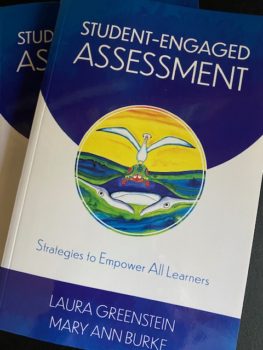How Teachers Use Students to Assess Learning
 How Teachers Use Students to Assess Learning
How Teachers Use Students to Assess Learning
This post is third of a series based on excepts from my book on Student-Engaged Assessment: Strategies to Empower All Learners by Laura Greenstein and Mary Ann Burke (2020). You can purchase the book from Roman and Littlefield for charts, examples, and worksheets on how to engage students to become owners of their learning successes.
Example of How Academic Standards Are Applied to Individualized Student Assessed Learning
As teachers increase their use of students to assess their own learning, lesson plans can include the academic standards that will be used in various project-based learning activities. The table below illustrates how specific academic standards can be integrated in various subject areas. Once the standards and activities are defined, teachers can assess each students’ learning readiness. Additionally, students must clarify how each standard can support a learning intention. Once students define a learning intention relevant to specific standards, they are able to identify how they will demonstrate their learning outcomes and rely on their own selection of resources to support their learning successes.
Student Readiness for Applying Standards to Learning Assessments
| Concept | In Practice |
| STANDARD
ELA: Reading informational texts Learning Intention: Recognize and explain or show how ideas and information are related. |
Science: Animal habitats or weather patterns
Social Studies: Colonization or conflicts ELA: Similarities between sources material Art: Comparisons of works of art |
| Step 1: READINESS
Assess prior learning and monitor readiness for learning.
|
Preassessment can include a KWL (we Know, Want to Know, and How we can Learn it) or a pretest similar to the post-test. With eyes closed, students display hand signals to indicate what they know and/or how they can do it…successfully, somewhat, not so much. |
| Step 2: READINESS
Deconstruct standards into learning intentions that are understandable, assessable, and actionable. |
What do your standards mean to the student? Use post-it notes (paper or electronic) for students to explain the meaning of the local learning intentions. |
| Step 3: READINESS
Learning opportunities and actions support the standards and intentions.
|
This is specific to your classroom and may range from teacher directed learning, to project-based, student demonstrations of learning, or teaching others. Formative assessments continuously monitor learning in relation to goals. |
| Step 4: Transitioning to Ownership
ENGAGE STUDENTS IN ASSESSMENT. Students track the learning process and outcomes.
|
Students increasing rely on their own selection of resources and have a growing choice in displaying their learning. They can rely on more formal assessments such as tracking progress on each of the learning intentions. Or, less formally, reflect and explain: “I used to think, but now I know.” |
| Step 5: Transitioning to Agency
STUDENTS TAKE RESPONSIBILITY for planning and monitoring learning. Evidence of progress is made visible. Formative assessments lead to or increase/foster/augment readiness and adjustment of reflection modifications. |
As students become more proficient at assessing their own learning, the responsibility transfers to them. With decreasing reliance on teachers for evaluating the learning, they become more proficient and comfortable in assessing their own learning. Teach what you learned to a Martian or
give an elevator pitch for peers to assess and give feedback in relation to learning intentions.
|
As students become confident in their abilities to apply academic standards to specific learning activities, they will develop self-confidence and achieve academic successes.
Our November 16th post will explain how students assess their learning outcomes. For more charts, examples, and worksheets on how to engage students to own their learning, you can purchase Student-Engaged Assessment: Strategies to Empower All Learners by Laura Greenstein and Mary Ann Burke (2020) from Roman and Littlefield.